How does Persistence influence the Cosmos ecosystem from liquid staking to re-staking innovations?
Author: TVBee
Persistence one ($XPRT) is one of the first Cosmos application chains to utilize IBC, CosmWasm, and the Liquid Staking Module (LSM). By continuously focusing on POS and liquid staking-related products, it has built a liquid staking and re-staking framework for the Cosmos ecosystem.
On December 5, 2023, the Cosmos community voted to allocate 600,000 ATOM to pSTAKE for liquid staking growth. pSTAKE shares 15% of its liquid staking revenue with the Cosmos Hub.
Persistence
Ecosystem
The Map of Zones visualization shows the influence of Persistence in the Cosmos ecosystem:

According to official data, the TVL of the Persistence ecosystem is $14.78 million, with an IBC trading volume of $15 million in the last 30 days and an average transaction cost of less than $0.005.

The Map of Zones data shows that the Persistence.one region has established 121 channels with 44 other regions in the Interchain network. This indicates that it is a highly interconnected node capable of interacting with many other regions through multiple channels.
74.7% of the network tokens ($XPRT) are staked, and a higher staking rate typically indicates greater network security and active participation. The annualized yield for staking is 16.7%.
Persistence's infrastructure consists of 6 nodes and 100 validators, collectively ensuring the decentralization and security of the network.
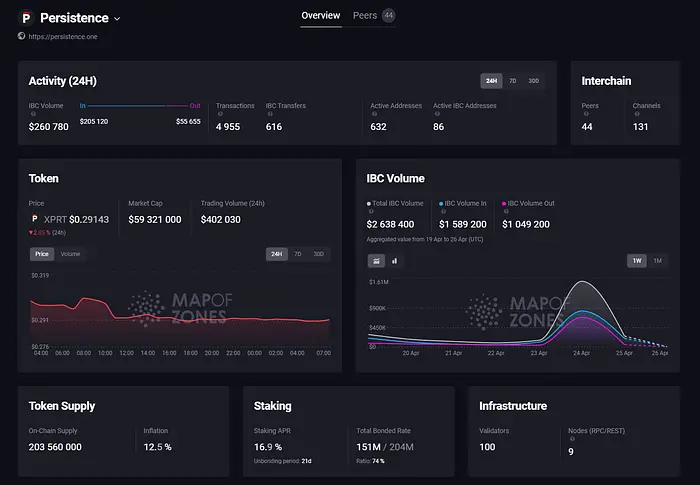
In the above ecosystem data, IBC (Inter-Blockchain Communication) is a core protocol of the Cosmos ecosystem, enabling interoperability between different blockchains. Through IBC, independent blockchains can seamlessly transfer tokens and other data types, making it possible to build cross-chain applications. The IBC trading volume reflects the scale of value inflow and outflow between the Persistence chain and external entities.
In the last 24 hours, the IBC trading volume for Persistence was $260,800, with 4,955 transactions, including 616 IBC transactions. There were 932 active addresses, with 86 active IBC addresses. Notably, IBC inflows consistently exceed outflows, indicating an increasing amount of value flowing into Persistence and participating in staking.
The staking platform pSTAKE is an important product for both the Persistence chain and the Cosmos ecosystem.
Technical Support
Persistence supports the CosmWasm framework, allowing developers to write secure and interoperable smart contracts in Rust. Additionally, DApps developed using the CosmWasm framework can run cross-chain via IBC, achieving cross-chain interoperability and providing convenient, secure, and efficient technical support for liquid staking.
Persistence connects to 54 Cosmos application chains via IBC for trustless communication, transferring, staking, and re-staking tokens, laying the ecological foundation for staking and re-staking in the Cosmos ecosystem.
Using Interchain Accounts (ICA), ICA Liquid Staking is realized. Interchain Accounts allow an account on one chain to perform operations on another chain, enhancing the efficiency and flexibility of staking and re-staking.
Liquid Staking
Staking and Network Security in the Cosmos Ecosystem
In the Ethereum ecosystem, the threshold for validator nodes is to stake more than 32 ETH. Liquid staking platforms like Lido allow users to stake small amounts of ETH, aggregating these funds to allocate to validator node operators in units of 32 ETH, thereby promoting an increase in the number of Ethereum validator nodes, which helps enhance the security and decentralization of the Ethereum network.
In the Cosmos ecosystem, liquid staking involves two roles—validators and delegators.
Stakers, or delegators, can choose the validator node to which they delegate their stake.
Validators run hardware and Cosmos SDK-based blockchain applications to reach consensus with other validators, proposing and validating new blocks on-chain.
If a validator exhibits negative behavior, the delegators of that validator node will face corresponding penalties. If a validator engages in improper behavior, including accidental or malicious prolonged offline status, the delegator's staked deposits may be destroyed or reduced by 0.1%. In cases of extremely malicious behavior, such as double-signing violations, where a validator signs more than once for a given block height, the staked deposits may be reduced by 5%.
Thus, the essence of liquid staking in the Cosmos ecosystem is to prevent malicious behavior through economic incentives and potential penalties. Validators and delegators share responsibility for maintaining network efficiency and security while earning token rewards.
pSTAKE Staking
pSTAKE ($PSTAKE) is part of the investment portfolio of Binance Labs and Coinbase Ventures.
pSTAKE provides a streamlined staking process for the Cosmos ecosystem. Users simply need to select the token to stake and the chain to stake on to begin staking.

Once staking is complete, the pSTAKE protocol issues corresponding staking rights tokens to the wallet. For example, staking ATOM can yield stkATOM.
Automatic Compounding
Taking stkATOM as an example, users earn daily staking rewards in ATOM, which are automatically reinvested into staking to continue earning rewards. Once the rewards are reinvested, it means that each stkATOM corresponds to an increased amount of staked ATOM, allowing users to receive more ATOM when they unstake. Therefore, the performance of user staking rewards is reflected in the increasing ratio of stkATOM/ATOM.
Unstaking
When users cancel their staking, they need to wait 21 to 25 days; alternatively, they can pay a 1% fee for instant unstaking. When users retrieve their staked assets, the corresponding stk assets are destroyed.
Staking Yield
The assets supported by pSTAKE staking and their current yield rates are shown in the table below:
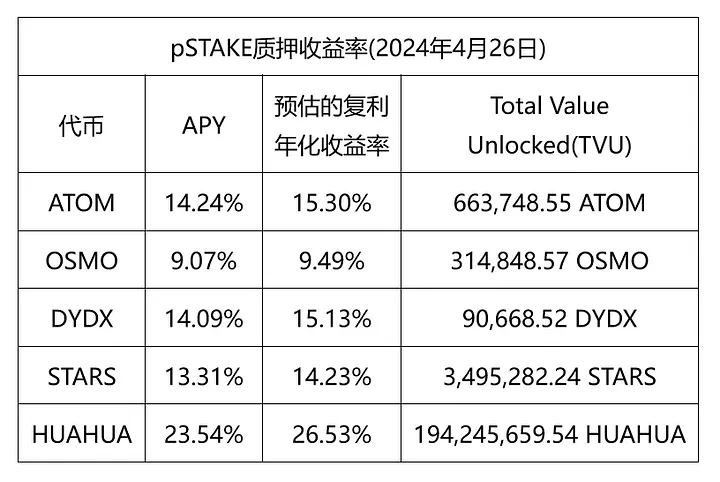
The estimated annualized yield from compounding is calculated based on the day's yield remaining constant.
Important Notes
pSTAKE currently supports ATOM on the Cosmos Hub, OSMO on the Osmosis chain, DYDX on the dYdX chain, STARS on Stargaze, HUAHUA on Chihuahua, and these five tokens minted on the Persistence chain.
When users choose to stake native chain tokens, pSTAKE staking involves two steps: transferring assets across chains to the Persistence chain via IBC, and then staking the assets using the liquid staking module on the Persistence chain.
Therefore, on pSTAKE, regardless of which chain's assets are staked, a certain amount of the base token of the Persistence chain—$XPRT—is required as GAS. Of course, the GAS on the Persistence chain is very low.
Staking Derivatives
Persistence and the Cosmos ecosystem have launched more stk asset derivative products.
For example, in DEX products, stkATOM can be directly exchanged for ATOM without needing to unstake or pay the 1% fee. Moreover, stk assets combined with native assets can also be added to liquidity in DEXs to achieve higher yields. For instance, in Dexter, a platform under Persistence, the expected annual yield for stkDYDX + DYDX is 45.82%.

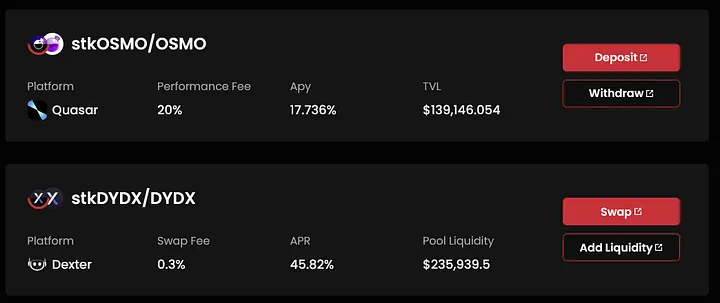

$XPRT Staking
As an independent blockchain, Persistence also requires staking to enhance network security.
It is easy to stake $XPRT on the Persistence official site or through the Keplr wallet.

After selecting the Persistence network, users can choose the validator node they wish to stake $XPRT with.
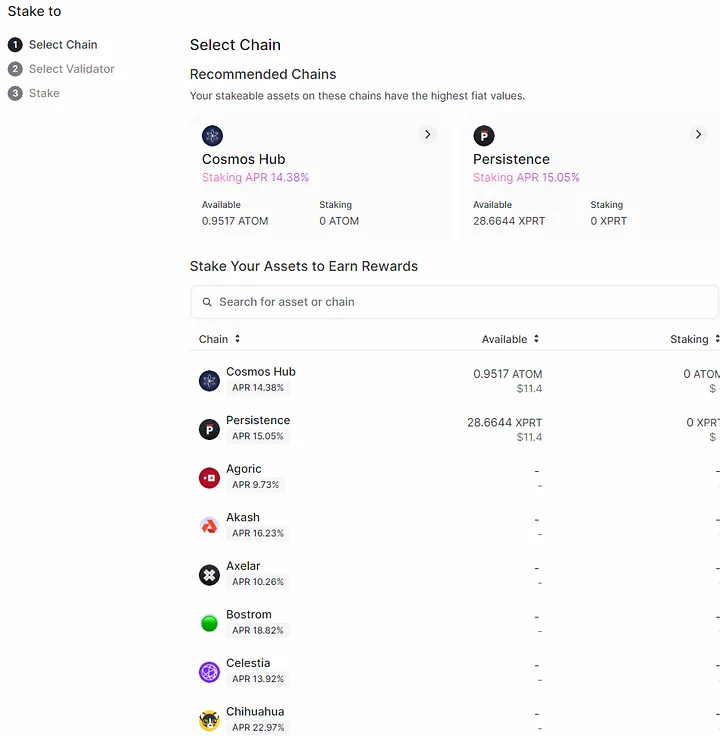
Staking Security
As a liquid staking platform, Persistence is a crucial cornerstone of security in the Cosmos ecosystem.
Both Persistence and pSTAKE are open-source programs, which is one of the guarantees of security. The pSTAKE program involves contributions from 72 developers, with the most recent code submission being two days ago.
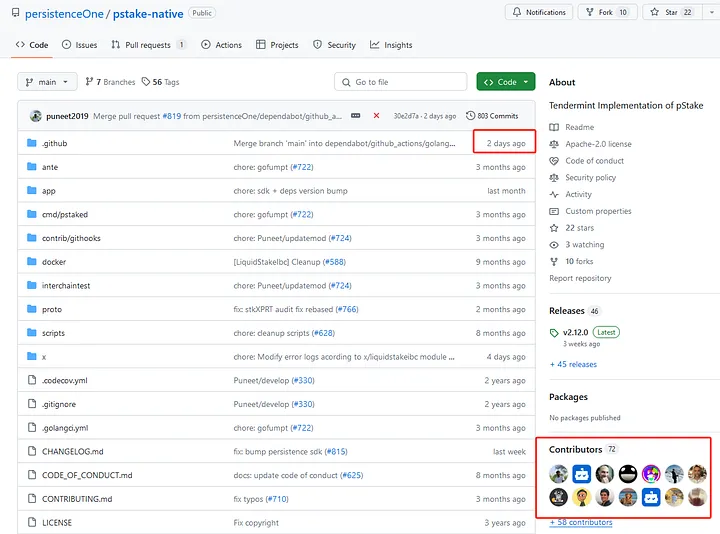
Furthermore, Persistence and pSTAKE collaborate with multiple security agencies to provide comprehensive support for the security of staking and re-staking. These security agencies include:
• Renowned blockchain and crypto security and auditing firms: Halborn, PeckShield, Certora, Hexens, and Notional;
• Global security research and consulting firm: Trail of Bits;
• Smart contract and related security auditing and consulting firms: Solidified, ConsenSys Diligence, Oak Security;
• Leading DeFi bug bounty platform: Immunefi.
• Real-time monitoring and alert network for blockchain security: Forta.
Re-staking
According to the Persistence blog, the project team is building re-staking infrastructure in Cosmos, allowing users to deposit liquid staking tokens (stkATOM, stTIA, stkDYDX, etc.) into Persistence via pSTAKE, Stride, and Quicksilver. This enables them to re-stake their assets and secure additional chains while earning extra rewards.
The Persistence re-staking module supports staking requests for various assets, such as staking rights tokens, stablecoins, LP tokens, etc.
Re-staking Alliance
The re-staking module of Persistence is developed based on the Alliance module. Alliance is an open-source Cosmos SDK module built by Terraform Labs that facilitates assets to be staked from one blockchain to another, leveraging inter-chain staking to create mutually beneficial relationships between blockchains.
For example, stakers of $XPRT, stkATOM, and stkTIA can join the re-staking asset alliance of Persistence after staking their respective assets. Stakers of stkATOM and stkTIA can earn re-staking rewards, as well as $XPRT.

The re-staking alliance shares staking rewards. Stakers of various assets are allocated rewards based on the reward weight of their assets. The reward weight for $XPRT is 1, while the reward weights for other assets are determined and adjusted through decentralized governance.
For instance, the reward weights for stkATOM and stkTIA are 0.4 and 0.2, respectively. Assuming that only $XPRT, stkATOM, and stkTIA are in the re-staking asset alliance, the reward distribution for these three assets would be:
$XPRT: 1/(1+0.4+0.2)=62.5%
stkATOM: 0.4/(1+0.4+0.2)=25%
stkTIA: 0.2/(1+0.4+0.2)=12.5%
This reward distribution mechanism for staking asset alliances in Persistence forms a coalition of re-staked assets, creating a community of shared interests that enhances the security and decentralization of the Cosmos ecosystem chain.
Sources of Re-staking Rewards
Tokens used for re-staking will be locked and proportionally minted into native tokens, which are then staked in the staking module as a delegator role to validators.
For example, tokens like stkATOM and stTIA staked by users will be locked in the re-staking module on the Persistence chain and proportionally minted into $XPRT. These $XPRT will be staked to validators, and the staking rewards will be distributed to stakers of stkATOM and stTIA.
This is the source of re-staking rewards in Persistence and further strengthens the security and liquidity of the Cosmos ecosystem chain.
In Conclusion
The Persistence chain provides an effective and secure economic infrastructure for liquid staking and re-staking in the Cosmos ecosystem. Through liquid staking products, Persistence is gradually deepening its influence within the Cosmos ecosystem, bringing higher security, asset liquidity, and ecosystem participation.
Persistence's innovative re-staking solutions establish an economic alliance for re-stakers. This alliance forms a cross-chain community of shared interests among re-stakers, enhancing mutual security and increasing the level of decentralization within the Cosmos ecosystem chain.










